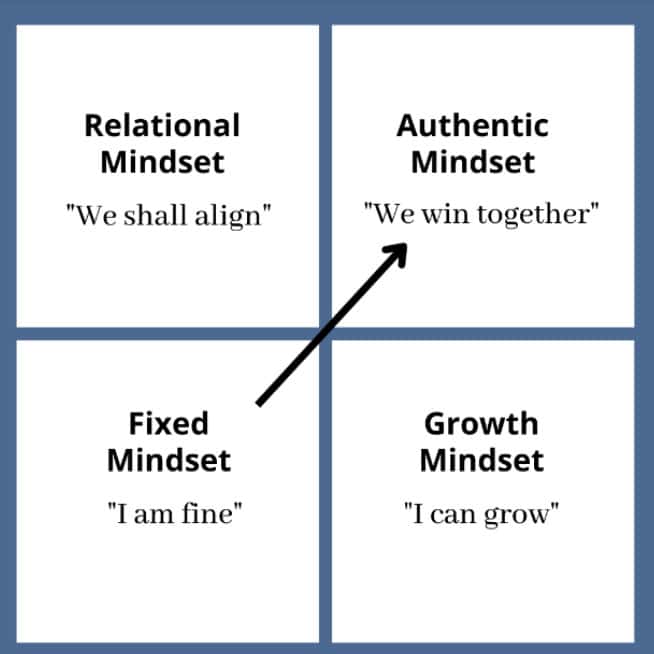To Achieve Top Performance, Growth Mindset is Not Enough

Ever since Carol S. Dweck’s groundbreaking book on Mindset in 2006, it has been considered a CEO imperative to create and sustain a growth mindset in their teams. Dozens and dozens of books, articles, and how-to guides have been written on the role of a growth mindset in curiosity, agility, innovation, resilience, betterment, and other skills required for success.
The reality, however, is that to achieve top performance growth mindset is rarely enough.
Why not?
Growth mindset is about individual performance. Top teams go beyond individual performance to focus on behaviors that align individuals and teams on growing and winning together.
As a CEO, you will find that building the right mindset requires your on-going attention — because for better or worse our brains are not wired to think in win-win terms.
Here are the steps you can take to build the right mindset to help your team achieve top performance.
- Growth Mindset as the Foundation
Growth mindset is a key foundation for top performance because it unlocks individual potential. Leaders with a growth mindset believe their team’s talent can be developed through lifelong learning, input from others, and hard work. This encourages growth and innovation.Leaders with a growth mindset also recognize that our instinctual brains are wired for middling, not top performance. People much smarter than me have shown this empirically. You can look at Herbert and Simon’s work on “satisficing” behavior. Or, Jonathan Haidt’s excellent summary in the book on The Righteous Mind on how our brains start with a conclusion and then look for evidence to support that conclusion rather than the reverse.
Recognizing that tendency toward a fixed mindset, CEOs who want to encourage a growth mindset create and model core company values that encourage:
1) Failure as a path to progress and flaws as opportunities to improve
2) Discovery, questioning, and information seeking behavior to improve decision-making
3) A focus on betterment and on-going improvement as a continuous goal
- Top Teams Align
Growth mindset will support individual achievement in almost any part of your organization — marketing, sales, product or operations. But, encouraging team members to build a growth mindset is not enough for top performance.Just as our brains are wired to start with a conclusion and then find evidence. Our brains are also wired to think of ourselves and our own individual advancement first. It is a natural act of self-preservation.
Growth mindset can just as quickly lead to competition as collaboration. It can lead to competition for attention, resources, or recognition that prioritizes individual outcomes over team outcomes.
Recognizing this, CEOs who lead top teams model and expect behaviors that align individual performance to team performance, including:
1) Reciprocity in relationships with a focus on shared goals and a shared commitment
2) Personalizing interactions and communications to get each team member input and buy-in
3) Active listening and recapping to confirm an understanding of each team member’s point of view - We Win Together
Aligning individual goals to team performance moves a company one step closer to top performance. But, teams themselves can become insular or succumb to the idea that some teams are better than others. After all, our instinctual brains are also wired to be tribal and hierarchical.Typically, before we can begin learning or looking for sources of innovation, we do a lot of credentialing.
➡ Who is teaching us?
➡ How experienced are they?
➡ Where do they sit in the hierarchy?So, the final step in building top performance is when CEOs focus on the idea: We win together.
They recognize learning can come from anywhere: from any buyer or customer, no matter how big or small; from any team member, no matter how junior or senior.
These CEOs encourage their teams to stop asking: “Has this person earned the right to teach me?” And, encouraging their teams to ask instead: “What can I learn from this person, regardless of their station?”
- The Example of Osmosis.org
Osmosis.org is an example of a company that experienced dramatic growth because of its CEO’s commitment to building an authentic mindset and creating behaviors to reinforce “we win together.”Osmosis.org is led by co-founder & CEO Shiv Gaglani. The company provides health education to millions of medical and healthcare professionals through a library of supplementary curriculum including 2,000+ instructional videos, study guides, and flashcards.
Under Shiv’s leadership, Osmosis has had an exceptional growth trajectory, scaling to over $10M in revenue and navigating a successful acquisition by Elsevier.
Shiv and Osmosis’s success had everything to do with a number of leadership practices used to continually shape the team’s mindset in the right direction. Three, in particular, stand out.
Aligning Goals to Individual Departments
The first is developing, with his senior leadership team (SLT), a collaborative process of aligning company goals to individual departments. Each year, the senior leadership teams read a book together designed to identify and align on strategies for the next phase of growth.
As part of the exercise, senior leaders complete a “pre-mortem” to reflect on their commitment to the company and to be intentional about their own careers with this thought exercise: “Fast forward one year, you are no longer here. Why is that? What does that suggest about your next phase at Osmosis?”
To cascade the idea of winning together into the organization, senior leadership is encouraged, but not required, to have their front-line managers and their direct reports go through the same process.
Ongoing “Stay” Interviews to Confirm Fit
The second practice to build an authentic mindset of winning together is the idea of a “stay” interview. Every single manager and employee is asked to complete a “stay” interview each six months to make sure individual performance and team goals are still aligned.
The manager is asked the questions: “Would I hire this person again?” and “If they were to leave, how hard would I fight to keep them?” The employee is asked: “If I were to leave this organization today, why would it be? Is it to try something new, to build a new skill set, to get a promotion?”
Honest and transparent conversations completed at a regular interval build an employee’s self-awareness about the right role and a manager’s self-awareness about the right team.
An Egalitarian Approach to Modeling Core Values
The third practice is the expectation and practice of modeling core values in an egalitarian way. During the company’s weekly all-hands meeting, SLT team members, frontline managers, and team members are asked to share specific examples of how they put the company’s six core values into practice.
Everybody in the company, regardless of their station, has an opportunity to be a leader in sharing and be a learner in identifying new practices that can reinforce core values.
In a world of continual change, the only constant is the need to regularly and intentionally reinforce the right mindset. Growth mindset is a great foundation to encourage individual performance, learning, and innovation. But, it is aligning individual effort to extended team goals and doing it in an egalitarian way that drives top performance.
Written by Brent Keltner.
Have you read?
Richest Actors In The World And Their Net Worth, 2023.
Richest Tennis Players In The world And Their Net Worth, 2023.
Study: Music successful CEOs and c-level executives listen to when they want to be more productive in 2023.
Which are the healthiest countries in the world for 2023?
Best Business Schools In The World For 2023.
Add CEOWORLD magazine to your Google News feed.
Follow CEOWORLD magazine headlines on: Google News, LinkedIn, Twitter, and Facebook.
Copyright 2024 The CEOWORLD magazine. All rights reserved. This material (and any extract from it) must not be copied, redistributed or placed on any website, without CEOWORLD magazine' prior written consent. For media queries, please contact: info@ceoworld.biz









